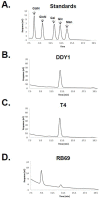The Odd "RB" Phage-Identification of Arabinosylation as a New Epigenetic Modification of DNA in T4-Like Phage RB69
- PMID: 29890699
- PMCID: PMC6024577
- DOI: 10.3390/v10060313
The Odd "RB" Phage-Identification of Arabinosylation as a New Epigenetic Modification of DNA in T4-Like Phage RB69
Abstract
In bacteriophages related to T4, hydroxymethylcytosine (hmC) is incorporated into the genomic DNA during DNA replication and is then further modified to glucosyl-hmC by phage-encoded glucosyltransferases. Previous studies have shown that RB69 shares a core set of genes with T4 and relatives. However, unlike the other “RB” phages, RB69 is unable to recombine its DNA with T4 or with the other “RB” isolates. In addition, despite having homologs to the T4 enzymes used to synthesize hmC, RB69 has no identified homolog to known glucosyltransferase genes. In this study we sought to understand the basis for RB69’s behavior using high-pH anion exchange chromatography (HPAEC) and mass spectrometry. Our analyses identified a novel phage epigenetic DNA sugar modification in RB69 DNA, which we have designated arabinosyl-hmC (ara-hmC). We sought a putative glucosyltranserase responsible for this novel modification and determined that RB69 also has a novel transferase gene, ORF003c, that is likely responsible for the arabinosyl-specific modification. We propose that ara-hmC was responsible for RB69 being unable to participate in genetic exchange with other hmC-containing T-even phages, and for its described incipient speciation. The RB69 ara-hmC also likely protects its DNA from some anti-phage type-IV restriction endonucleases. Several T4-related phages, such as E. coli phage JS09 and Shigella phage Shf125875 have homologs to RB69 ORF003c, suggesting the ara-hmC modification may be relatively common in T4-related phages, highlighting the importance of further work to understand the role of this modification and the biochemical pathway responsible for its production.
Keywords: RB69; T4 phage; anion exchange chromatography; arabinosyl-hmC (ara-hmC); epigenetic modification; glucosyl-hmC (ghmC); glucosyltransferase transferase; hydroxymethylcytosine (hmC); matrix assisted laser desorption ionization-time of flight (MALDI-TOF) mass spectrometry; restriction.
Conflict of interest statement
The authors declare no conflict of interest.
Figures







Similar articles
-
Landscape of New Nuclease-Containing Antiphage Systems in Escherichia coli and the Counterdefense Roles of Bacteriophage T4 Genome Modifications.J Virol. 2023 Jun 29;97(6):e0059923. doi: 10.1128/jvi.00599-23. Epub 2023 Jun 12. J Virol. 2023. PMID: 37306585 Free PMC article.
-
A type IV modification dependent restriction nuclease that targets glucosylated hydroxymethyl cytosine modified DNAs.J Mol Biol. 2007 Feb 23;366(3):768-78. doi: 10.1016/j.jmb.2006.11.051. Epub 2006 Nov 21. J Mol Biol. 2007. PMID: 17188297 Free PMC article.
-
Covalent Modification of Bacteriophage T4 DNA Inhibits CRISPR-Cas9.mBio. 2015 Jun 16;6(3):e00648. doi: 10.1128/mBio.00648-15. mBio. 2015. PMID: 26081634 Free PMC article.
-
Phage-exclusion enzymes: a bonanza of biochemical and cell biology reagents?Mol Microbiol. 1995 Feb;15(3):415-20. doi: 10.1111/j.1365-2958.1995.tb02255.x. Mol Microbiol. 1995. PMID: 7540246 Review.
-
5-Hydroxymethylcytosine, the sixth base of the genome.Angew Chem Int Ed Engl. 2011 Jul 11;50(29):6460-8. doi: 10.1002/anie.201101547. Epub 2011 Jun 17. Angew Chem Int Ed Engl. 2011. PMID: 21688365 Review.
Cited by
-
Phage Genome Annotation: Where to Begin and End.Phage (New Rochelle). 2021 Dec 1;2(4):183-193. doi: 10.1089/phage.2021.0015. Epub 2021 Dec 16. Phage (New Rochelle). 2021. PMID: 36159890 Free PMC article.
-
Novel bacteriophages targeting wheat phyllosphere bacteria carry DNA modifications and single-strand breaks.Virus Res. 2025 Feb;352:199524. doi: 10.1016/j.virusres.2024.199524. Epub 2025 Jan 8. Virus Res. 2025. PMID: 39742975 Free PMC article.
-
Hypermodified DNA in Viruses of E. coli and Salmonella.EcoSal Plus. 2021 Dec 15;9(2):eESP00282019. doi: 10.1128/ecosalplus.ESP-0028-2019. Epub 2021 Sep 28. EcoSal Plus. 2021. PMID: 34910575 Free PMC article. Review.
-
Diverse bacteriophages for biocontrol of ESBL- and AmpC-β-lactamase-producing E. coli.iScience. 2024 Jan 17;27(2):108826. doi: 10.1016/j.isci.2024.108826. eCollection 2024 Feb 16. iScience. 2024. PMID: 38322997 Free PMC article.
-
Influence of Non-canonical DNA Bases on the Genomic Diversity of Tevenvirinae.Front Microbiol. 2021 Apr 6;12:632686. doi: 10.3389/fmicb.2021.632686. eCollection 2021. Front Microbiol. 2021. PMID: 33889139 Free PMC article.
References
-
- JKutter E., Stidham T., Guttman B., Kutter E., Batts D., Peterson S., Djavakhishvili T., Arisaka F., Mesyanzhinov V., Ruger W., et al. Genomic map of bacteriophage T4. In: Karam J.D., editor. Molecular Biology of Bacteriophage T4. ASM Press; Washington, DC, USA: 1994. pp. 491–519.
Publication types
MeSH terms
Substances
Grants and funding
LinkOut - more resources
Full Text Sources
Other Literature Sources

